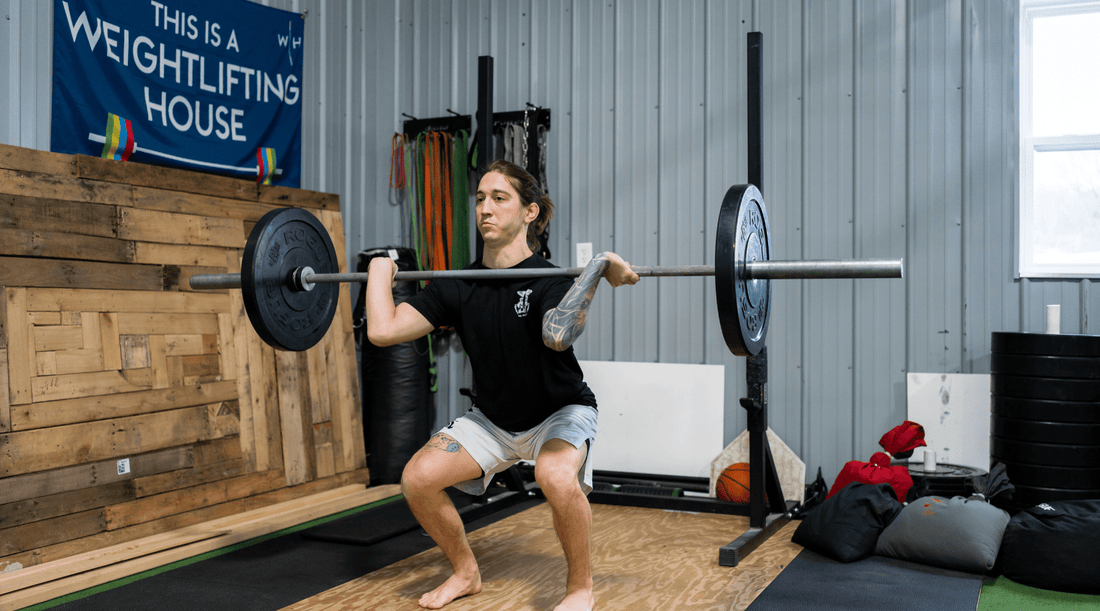When you watch an Olympic Weightlifter perform a clean and jerk or a snatch, it comes as no surprise that Olympic Weightlifting requires a significant amount of mobility, strength, and coordination to complete the lift. If you’re an Olympic Weightlifter yourself, which is probably why you clicked on this blog post ;), then you’ve most likely run into a mobility issue at some point in your lifting career. Whether you’ve had difficulty getting sufficient depth on your catch during a clean or getting into an overhead position during your snatch, this blog post is for you.
Mobility vs Flexibility: What’s the Difference?
First, let’s talk about what mobility is. Often the general public equates mobility with flexibility, but these two concepts are not the same thing. Flexibility refers to the ability of a muscle to passively lengthen. Think static stretching. Mobility on the other hand refers to the ability of a joint to actively move through a complete range of motion. Mobility requires flexibility, but it also requires strength and neuromuscular control. When lifters hear from their coach that they need to work on their mobility, they typically go to static stretching or foam rolling. While stretching can provide short term improvements in mobility, it does not provide the strengthening stimulus necessary to create a long term adaptation in the nervous system. Additionally, static stretching (>60s) before lifting has been shown to significantly decrease power output due to down regulation of the nervous system.
So, what should you do during your warmup? Well it truly depends on what your limitations are and what your lifts look like for the day. A warmup should consist of cardio, dynamic stretches, and movement primers. Think of movement primers as a way to prime or “wake up” your nervous system. Movements primers are preparatory exercises and drills that help to improve active joint range of motion, motor control, proprioception/coordination, and movement quality. These primers should be specific to your individual mobility restrictions.
Common Mobility Limitations with Olympic Weightlifting
As a physical therapist that regularly works with Olympic Weightlifters, I tend to see some common patterns of restriction. Let’s go through some of the most common problem areas seen with Olympic Weightlifters.
Thoracic Spine Mobility
One of the most common restrictions I see in Olympic Weightlifters is a lack of thoracic extension mobility. Olympic Weightlifting requires a significant amount of thoracic extension. During the clean, thoracic extension helps to maintain an upright torso, which helps to keep the bar close to the body, minimizing horizontal bar displacement and improving energy efficiency. When this thoracic extension is not present, I tend to see compensation of the lumbar spine to create extension. This often leads to low back pain due to increased load and demand put on the lumbar spine.
Thoracic extension is also a crucial factor in attaining and maintaining full overhead mobility during the jerk and snatch. This lack of thoracic extension in the overhead position leads to increased load on the shoulder joint, which often leads to pain.
A great movement primer for improving thoracic extension mobility is the long sit overhead press. By utilizing a long sit position we can create tension through the thoracolumbar fascia with a posterior pelvic tilt, preventing compensation from the lumbar spine for extension.
Hip Mobility
Another common area of restriction that I see is a lack of hip internal rotation mobility. And you may be thinking, I thought I needed to work on hip external rotation mobility? While external rotation of the hip is thought to be the most important motion to improve squat/catch depth, hip internal rotation may be even more so. The reason for this is that once you go below parallel in a squat, the pelvis must rotate relatively into hip internal rotation. Limitation in hip internal rotation is typically the culprit when I see lifters experiencing a pinching, painful sensation in the hip when they go into a deep squat.
One of my favorite movement primers to improve hip internal rotation is the seated sumo good morning. This primer emphasizes the relative rotation of the pelvis on the hip. Focus on actively driving the knees outward as you hinge forward. Progress by gradually adding load via kettlebell or dumbbell.
My Role as a Physical Therapist
Often I work with lifters looking to continue performing at a high level regularly. This is why Totem was created. We understand that the whole reason that you’re seeking help is to return to the things that you want to do, and we want to give you a strategy to do so effectively. So many times we hear from our athletes that they’ve been told to find a new hobby, or that the only way to deal with their pain is to get an invasive surgery. This is, frankly, terrible advice in most circumstances.
Here at Totem, located at Pittsburgh Barbell Club in Bridgeville, PA, we specialize in movement analysis and early integration of training in the rehabilitation process. During our Movement Evaluation, we break down your movement patterns and identify the root cause of the issue you’re experiencing. From there, we develop a clear strategy to help you return to doing the things that you love to do.
Conclusion
Sufficient thoracic spine and hip mobility are important factors in Olympic Weightlifting. Consistently incorporating movement primers into your warmups to improve your mobility before your workouts will help to improve your overall performance and reduce the risk of injury.
If you’re struggling with pain or limitations in mobility during your lifts, schedule a Movement Evaluation with one of our Doctors of Physical Therapy today!

